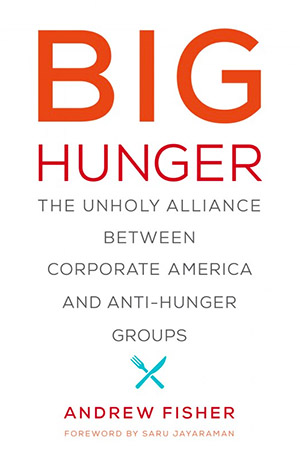How One Organization Can Shorten Food Bank Lines Across the United States

Dedicated to the memory of Hank Herrera, a lifelong advocate for racial justice.
This is the time of year when middle-class America gives thanks for our privilege, and considers the plight of the less fortunate. We staff the turkey dinner lines at the local homeless shelter, donate cans to the food drive, or write checks to the food bank. We do so regardless of our partisan affiliation, race, or geographical location.
Food charity is, after all, one of the few things that historically has united most Americans. While we remain a country deeply divided, it has become America’s lowest common denominator. Even the mean-spirited Trump administration has poured at least $10 billion into food banks since 2017.
The outpouring of charitable donations to food banks in the wake of the Covid economic crash makes me appreciate that we, as a nation, retain some sense of caritas, even while millions of President Trump’s supporters scoff at masks and flip the bird to any sense of communal responsibility. Yet it also frustrates me that distributing more free food, even when it is grown organically by farmers of color, is all we can seem to manage as a response to this dire situation. Never let a good crisis go to waste, Sir Winston Churchill used to say.
Never let a good crisis go to waste, Sir Winston Churchill used to say.
In 2020, when America is gasping for breath, from the smoke that chokes the West Coast, police brutality, a democracy on life support, and 12 million (and counting) people struggling with Covid-19, I wonder if our collective sense of imagination and action has become so limited that the best we can do is to give organic veggies to the millions of newly unemployed? Where is our vision? Our political project?

At a moment when America’s seamy underbelly and gaping wounds of inequities, racial and otherwise, have been exposed like no time since 1929, I wonder what does it take to turn the apolitical food bank industry onto progressive politics. I keep hoping that food bankers will recognize the urgency of structural change, and embrace progressive values. Black Lives Matter. Reparations. The Green New Deal. Medicare for All. A $15 minimum wage. This is the language of social change in America. Yet, the food charity sector has almost unanimously failed to embrace any of these strategies.
For the past 40 years, since the explosion of food banks in the early 1980s, we have been handling hunger as if we were doctors, with doses of medicine in the form of food giveaways. We have been treating the symptoms and ignoring the disease. At the heart of this medical model, or hunger industrial complex — the web of connected corporations, anti-hunger groups, and government agencies that perpetuate hunger because it is profitable — sits the charity behemoth Feeding America. The nation’s second largest charity, with a $2.8 billion budget, it deploys a network of 200 food banks across the entire country, distributing 4.6 billion pounds of food annually.
Feeding America and its affiliated food banks possess an unparalleled potential to mobilize our anti-hunger response toward social, racial, and economic justice. They feed 40+ million people, engage millions of volunteers, and reach tens of millions of donors every year. They could be mobilizing and organizing half of America to take bold political action. They can be at the forefront of working with poor people to help them build power and wealth. But progress remains geographically uneven and sporadic.
The silver lining in this horrible year can be that food bankers finally step on the gas and accelerate toward justice. They will need a road map to get there. Here, I propose a 10-point plan for how Feeding America could play a leading role in substantially reducing the incidence of food insecurity for millions of Americans.
1. Support labor-friendly policies, including a higher minimum wage
Analysis: Prior to the pandemic, the vast majority of emergency food recipients were employed, largely at jobs that paid low wages, or where they were unable to gain full-time work on a regular basis. The minimum wage still remains at $7.25 in 21 states. A $15 minimum wage would make 1.2 million households food secure. Yet, Feeding America and the vast majority of its network have failed to take a position on raising the minimum wage, either nationally or at the state level.
Action: Feeding America and its network need to support a national $15 minimum wage by 2023, starting first with paying a living wage to its own employees and contractors. Yet raising the minimum wage is just one part of the solution. Other important policies that they should support include eliminating the sub-minimum tipped wage for restaurant employees, and establishing predictive scheduling, paid sick leave, and anti-wage theft policies. Oregon Food Bank has done an exemplary job here.
2. Place racial equity at the center of their work
Analysis: Racism is at the root of poverty, which is in turn at the root of hunger. Yet the emergency food system only reinforces this racism, both at the inter-personal and structural levels. For example, volunteers (disproportionately white) get to control what recipients (disproportionately people of color) get to eat. The system does little to build power, wealth, or agency for their patrons.
Action: Like most non-profit organizations and other institutions in the United States, food banks need to own their legacy and 40-year history of unconsciously perpetuating structural racism before they can undo the harm they have done. They should seek to dismantle racist practices within their organization, and become strong forces for anti-racism. They can develop an action plan to make changes, such as advocating for dismantling the policies and practices that perpetuate gaping health inequities linked to social determinants of nutritious food access, holding themselves accountable to the communities that they serve. Follow the lead of the Oregon Food Bank in this area.
3. Expand SNAP organizing
Analysis: SNAP provides nine times the amount of food as food banks. It is the keystone to ensuring food security, yet its benefit levels are set at unrealistically low levels. Feeding America has dedicated substantial resources to fighting against new restrictions and for expanded funding during the pandemic.
Action: This is one area in which Feeding America could not only expand its own staffing but fund organizing positions in key states to grow the SNAP program. It should place SNAP as its top policy priority alongside advocating for an increased minimum wage. Bread for the World does an exemplary job of mobilizing its communities toward policy action.
4. Diversify their Board
Analysis: Who’s at the table shapes what’s on the agenda. And by and large, it’s white people who work in corporate America who sit on food bank boards. My own review found that 22 percent of the board members of food banks worked at Fortune 1000 companies or their private sector equivalent. Very few are persons of color and even fewer are people with lived experience of hunger. These governance structures keep food banks as appendages of the food industry, not as agents of social change.
Action: Feeding America and its affiliates need to be held accountable to the people and communities that they serve. They should set ambitious targets for board diversity, including by occupation, ethnicity, gender, and include people with lived experience of food insecurity, and provide incentives for the network to do the same. Look to the Alameda County Community Food Bank in Oakland, CA, for an example of how to engage community residents in its public policy advocacy.
5. Establish a strategic plan for a 50 percent reduction in food banking from pre-Covid levels by 2028
Analysis: Before the pandemic, the amount of food distributed by Feeding America food banks doubled over the past decade. Part of this increase is due to contractual obligations that mandated a 50 percent increase of food distributed per person in poverty. Despite this increase in food distribution, food insecurity did not dip below 1995 levels until 2018. Clearly there is not a statistically significant link between reducing food insecurity and emergency food distribution.
Action: As part of its annual contract with its network, Feeding America should stipulate a reduction in the amount of food delivered per person in poverty with a corresponding increase in other social indicators, such as social capital, poverty reduction, and resilience. They can reorient funding, such as the $100 million Jeff Bezos donated, to strategic shrinking initiatives to address the root causes of hunger, rather than expanded capacity. Bring in community members with lived experience of poverty, alongside researchers to help develop innovative measures of success, beyond just persons served and pounds distributed. Look to the great work of the Community Food Centres of Canada for innovation in measuring success beyond food distribution.
6. Reorient their communications
Analysis: For far too long, Feeding America and its affiliates have systematically misled the public that charity can end hunger. It’s been done in the name of raising funds to keep their good work going. It’s led to a crisis of imagination, which has, in the current pandemic, meant that funders double down on hunger relief efforts rather than addressing the root causes.
Action: Revise their communication strategy to reinforce new root cause-oriented programming. Tell the public that we can’t food bank our way out of hunger, and that’s why we’re investing more funding into fighting tomorrow’s hunger through policy advocacy, human development, and addressing the social determinants of health. Boldly name the root causes of hunger and debunk the bootstraps myth that prevents our country from fulfilling its protective obligations to our most vulnerable citizens. Consider Northwest Harvest’s role to get passed a constitutional amendment in Washington to establish the right to food.
7. Put a moratorium on expansion
Analysis: Buildings become stakeholders. The bigger the food bank building, the more sophisticated the infrastructure, the more pressure staff and Board will feel to ramp up their distribution efforts. It’s like building a new lane on the freeway to reduce congestion. It doesn’t work. It just creates more traffic. For too long, food banks have seen newer, shinier, bigger digs with larger freezers and coolers as a key strategy to expanding their capacity to feeding the need.
Action: Feeding America should put into its contract language a clause to actively discourage and penalize food banks that undertake expansion campaigns. Similarly, they should seek to diminish their food procurement department while redirecting resources to policy advocacy, organizing, and a new department of strategic shrinking. Foodlink in Rochester, NY, did a great job of not expanding, but instead using its space strategically to support community-based food businesses.
8. Keep up the great work on health and take it to the next step
Analysis: In the face of epidemics of obesity and diabetes, the quality of the food passing through Feeding America’s network has undeniably improved in recent years. The amount of produce has increased dramatically. More food banks have nutrition policies and staff to evaluate the quality of the product they distribute. Roughly one in seven food banks no longer accept soda or candy.
Action: Feeding America has done a good job of increasing produce distribution, but has largely failed to limit unhealthy foods in the system. Mazon’s seminal report (A Tipping Point) has shown how snack foods and baked goods are still overrepresented in food pantries. They should set national standards, rejecting sugary beverages and candy, while continuing to fund projects that connect food banks with local agriculture. Similarly, they should recognize that access to health care is a critical variable in the health and financial status of its clientele (medical bills are the primary cause of bankruptcies in the U.S.), and should actively support universal free health care. Consider the work of the Food Bank of Santa Barbara County (CA) to re-focus itself on improving community health as its core purpose.
9. Re-examine the relationship between food banks and Big Food and Big Ag
Analysis: The Feeding America network has a massive conflict of interest problem on its hands through its reliance on corporations with egregious labor, health, and environmental practices such as Smithfield, Walmart, Amazon, and Tyson. These are companies that cause hunger among their millions of employees through their practices, yet Feeding America casts them as hunger fighters in their partnership promotions.
Action: Until Feeding America approves corporate donation policies that establish clear criteria for its acceptance of food and cash, it will continue to be ethically compromised. Its continued relationship with agri-business enables them to over-produce, while having the benefit of a morally acceptable way to dispose of their surplus products. Feeding America needs to adopt a more sophisticated analysis of its role in promoting food waste and in enabling bad actors to continue their egregious labor practices. Look to WhyHunger for model corporate donation policies, as a starting point.
10. Embrace sustainable food systems as a core part of their mission
Analysis: As some of the largest food-oriented non-profits with transportation staffing, and cooling resources, food banks can and should play a role in supporting community economic development programs in their local area. Many food banks have indeed become an integral element of their local food systems, through buying from local farmers, allowing local businesses to utilize their facilities off-hours, serving as a food hub, hosting farmers markets, supporting community gardening programs, and operating organic farms.
Action: While many individual food banks have embraced local food systems as a core part of their work, they have done so largely without support from Feeding America. Feeding America can play many roles, such as aggregating data about the impacts of the work of individual food banks in this area, providing financial resources, researching and disseminating information on best practices, as well as communicating to the public about the importance of these efforts. The Food Bank of Northern Alabama and the Atlanta Community Food Bank have done exemplary work in this area.
Andrew Fisher has worked in the anti-hunger field for 25 years, as the executive director of national and local food groups, and as a researcher, organizer, policy advocate, and coalition builder. He is the author of “Big Hunger: The Unholy Alliance between Corporate America and Anti-Hunger Groups.”



